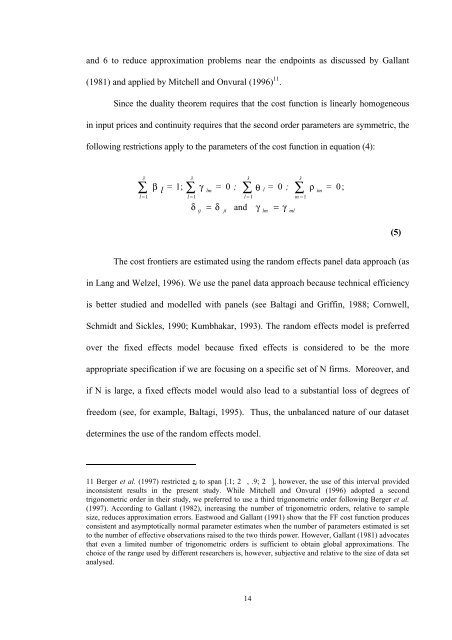Efficiency in Banking: Empirical Evidence from the Savings ... - Ivie
You also want an ePaper? Increase the reach of your titles
YUMPU automatically turns print PDFs into web optimized ePapers that Google loves.
and 6 to reduce approximation problems near <strong>the</strong> endpo<strong>in</strong>ts as discussed by Gallant<br />
(1981) and applied by Mitchell and Onvural (1996) 11 .<br />
S<strong>in</strong>ce <strong>the</strong> duality <strong>the</strong>orem requires that <strong>the</strong> cost function is l<strong>in</strong>early homogeneous<br />
<strong>in</strong> <strong>in</strong>put prices and cont<strong>in</strong>uity requires that <strong>the</strong> second order parameters are symmetric, <strong>the</strong><br />
follow<strong>in</strong>g restrictions apply to <strong>the</strong> parameters of <strong>the</strong> cost function <strong>in</strong> equation (4):<br />
3<br />
∑<br />
l= 1<br />
β<br />
l<br />
=<br />
1;<br />
3<br />
∑<br />
l= 1<br />
δ<br />
γ<br />
ij<br />
lm<br />
=<br />
= 0<br />
δ<br />
ji<br />
;<br />
3<br />
∑<br />
l= 1<br />
θ<br />
and γ<br />
l<br />
lm<br />
= 0 ;<br />
= γ<br />
ml<br />
3<br />
∑<br />
m = 1<br />
ρ<br />
im<br />
=<br />
0;<br />
(5)<br />
The cost frontiers are estimated us<strong>in</strong>g <strong>the</strong> random effects panel data approach (as<br />
<strong>in</strong> Lang and Welzel, 1996). We use <strong>the</strong> panel data approach because technical efficiency<br />
is better studied and modelled with panels (see Baltagi and Griff<strong>in</strong>, 1988; Cornwell,<br />
Schmidt and Sickles, 1990; Kumbhakar, 1993). The random effects model is preferred<br />
over <strong>the</strong> fixed effects model because fixed effects is considered to be <strong>the</strong> more<br />
appropriate specification if we are focus<strong>in</strong>g on a specific set of N firms. Moreover, and<br />
if N is large, a fixed effects model would also lead to a substantial loss of degrees of<br />
freedom (see, for example, Baltagi, 1995). Thus, <strong>the</strong> unbalanced nature of our dataset<br />
determ<strong>in</strong>es <strong>the</strong> use of <strong>the</strong> random effects model.<br />
11 Berger et al. (1997) restricted z i to span [.1; 2, .9; 2], however, <strong>the</strong> use of this <strong>in</strong>terval provided<br />
<strong>in</strong>consistent results <strong>in</strong> <strong>the</strong> present study. While Mitchell and Onvural (1996) adopted a second<br />
trigonometric order <strong>in</strong> <strong>the</strong>ir study, we preferred to use a third trigonometric order follow<strong>in</strong>g Berger et al.<br />
(1997). Accord<strong>in</strong>g to Gallant (1982), <strong>in</strong>creas<strong>in</strong>g <strong>the</strong> number of trigonometric orders, relative to sample<br />
size, reduces approximation errors. Eastwood and Gallant (1991) show that <strong>the</strong> FF cost function produces<br />
consistent and asymptotically normal parameter estimates when <strong>the</strong> number of parameters estimated is set<br />
to <strong>the</strong> number of effective observations raised to <strong>the</strong> two thirds power. However, Gallant (1981) advocates<br />
that even a limited number of trigonometric orders is sufficient to obta<strong>in</strong> global approximations. The<br />
choice of <strong>the</strong> range used by different researchers is, however, subjective and relative to <strong>the</strong> size of data set<br />
analysed.<br />
14
















